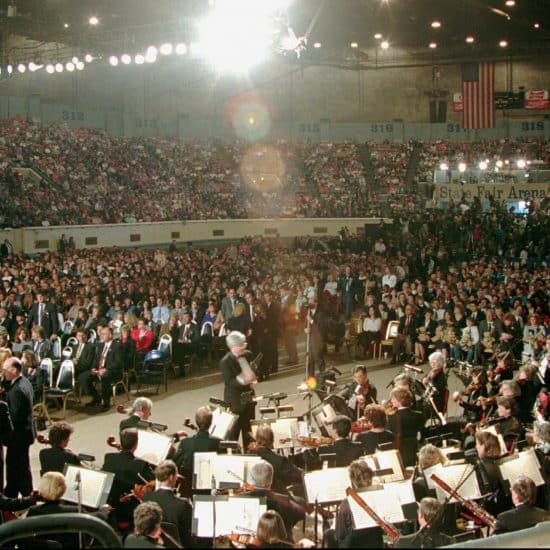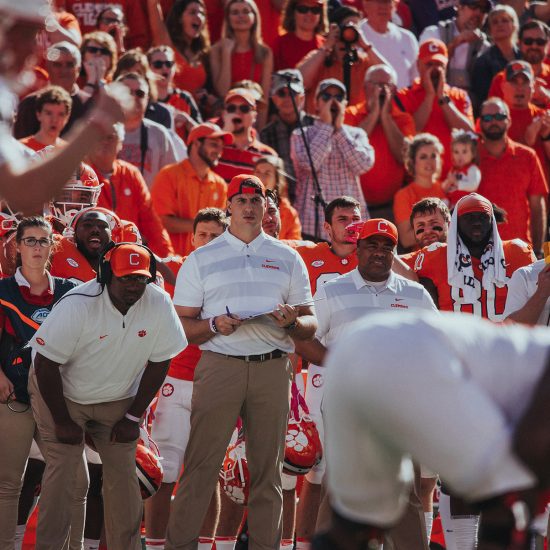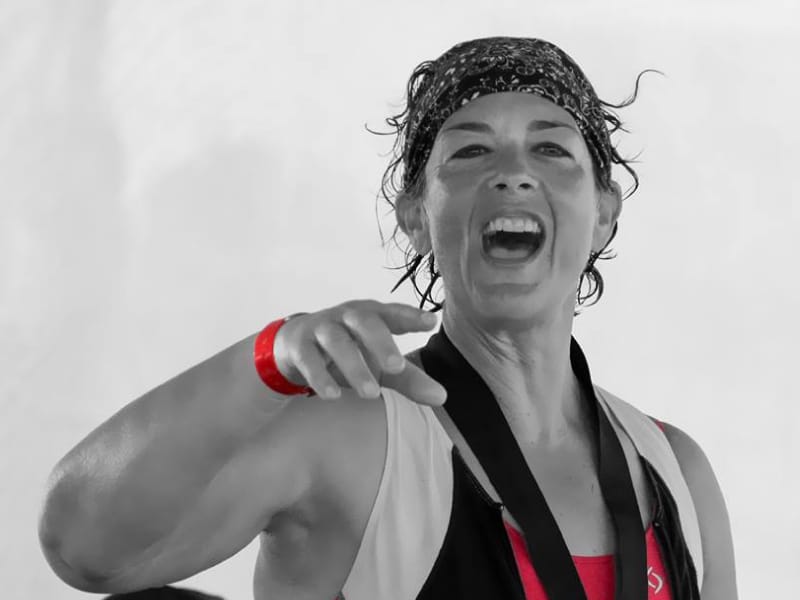
Still in her desk chair, a window curtain somehow wrapped around her face, Amy Downs spent six hours in the rubble of the Alfred P. Murrah Federal Building in Oklahoma City.
Even before the truck bomb detonated – ejecting her from a third-floor window and plunging her into the basement, folded into a V-shaped space with her head wedged below the knees – Amy’s life already was a mess.
At 28, she was an unhappily married college dropout. She’d lost her faith. She weighed 355 pounds.
Surviving was the perfect opportunity for a fresh start. If nothing else, it would’ve been understandable to leave a job now haunted by reminders of those who weren’t as fortunate, like the pregnant woman she’d been talking to at 9:02 a.m. on April 19, 1995.
Instead, the next day, from her hospital bed, Amy finished a live interview on the “Today” show and began making work calls. As a loan officer for the Federal Employees Credit Union, she needed to help her clients – those who survived and the families of those who didn’t.
Of the 168 victims, about 100 were clients. Another 18 were colleagues.
As the 25th anniversary of that horrific episode in U.S. history approaches – and with it arriving during another unsettling time – Amy’s devotion to her job might seem like an odd focus. Except, amazing things have sprung from it.
That clinically obese young woman evolved into an Ironman triathlete. The gal with the 0.50 college GPA earned a master’s degree. She renewed her faith and found true love. And since January 2018, she’s had a new role at that credit union now known as Allegiance: president and CEO.
So, for anyone frightened about life being upended by the coronavirus, struggling to create a new way of life, or seeking to emerge from this ordeal on a better path, Amy’s journey offers clues and, most of all, hope.
“I have this little trick my boss taught me one time,” she said. “Imagine you have a magic wand. What would you do with it?
“Then ask what you can do to move toward that direction.”
***
Stories about the fateful day often mention the weather. Postcard-perfect, with temperatures declaring the end of winter.
Amy’s desk faced that cloudless sky in front of the building.
Until explosives sheared that entire façade.
She heard a popping sound. The next thing she remembers is darkness. And hearing screaming. Lots of screaming.
She eventually realized it came from her.
Her awkward position created the sensation of being upside down. She wondered whether she was alive.
Unsure, she prayed.
“I would like to say I cried out to God, and I felt God’s peace,” she said. “That’s not what happened. It was actually cold and dark and lonely.”
She tried quoting Scripture. All she remembered were versions of the line, “I walk through the valley of the shadow of death.”
She heard people talking. They were looking for the daycare center. She called out, guiding them to her pile of rubble. Although her right arm was wrenched behind her, she squeezed that hand far enough out for someone to grab it.
That man and another discussed how to get her out. Before they could even try, they had to leave. Fears of another, bigger blast prompted cries for everyone to get out.
***
Alone, all sorts of images flooded her mind – including, for the first time in her life, the desire to become a mother.
And now she might die any second.
A song from childhood sprang from her lips: “I love you, Lord, and I lift my voice to worship you. Oh, my soul rejoice. Take joy, my king, in what you hear. Let it be a sweet, sweet sound in your ear.”
The song spurred “something supernatural.” She felt as if she was looking at herself from outside her body.
“That was when I really did feel God’s presence,” she said. “I promised God I would never live my life the same.”
The new perspective zoomed in on her values. She cared more about money and things than faith and relationships.
“I was too self-centered,” she said. “It bothered me to see that I had never done anything to help other people.”
Then Allen Hill touched her hand.
“We were the first crew released back in,” Hill said. “We got a radio transmission that the basement was filling with water so to concentrate there first.”
As Hill and the crew whacked through stone and steel, Amy began making good on her new, more-generous mindset. She told the guys she’d bake them cookies.
She amused herself by pondering sugar or chocolate chip.
She also remembered she didn’t know how to make either. Finally, she had reason to laugh.
***
Her last name then was Petty.
In the late 1980s, a bad breakup prompted her to flee her hometown of Shreveport, Louisiana, for Oklahoma City, near one of her sisters. A blind date with a guy at church – a man with a degree in Bible studies – turned into a walk down the aisle months later.
She hoped for a fairytale life together – or at least for the life as a pastor and a pastor’s wife. Her aspirations fizzled quickly. They became more like roommates. She gained 100 pounds by their first anniversary.
“My hobbies were watching TV and eating,” she said.
There were many reasons she didn’t want to bring a child into that life. After several “very dark” years following the bombing, she was ready to try becoming a mother.
“But I was an unhealthy weight,” she said. “I miscarried.”
A year later, she delivered her son, Austin.
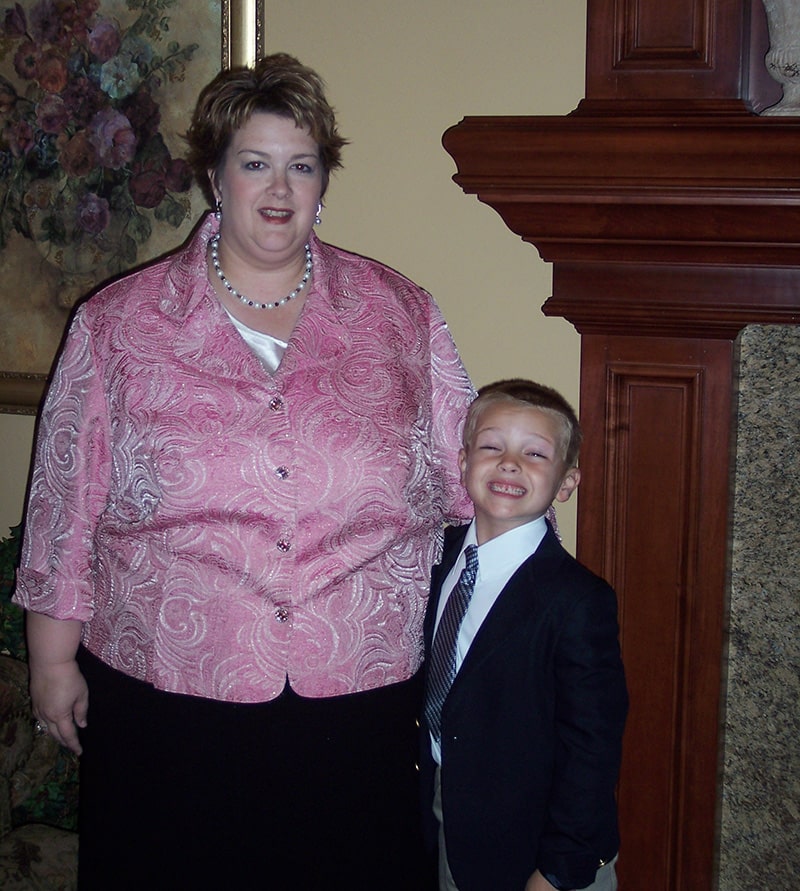
Amy Downs with her son, Austin. (Photo courtesy of Amy Downs)
***
Before motherhood, Amy mostly found joy through work.
She’d started as a teller. In those early days, she learned a credit union was more co-op than bank. Everyone was in it together. Turning a profit mattered less than helping clients. This felt like the ministry work she thought she’d married into.
Proof came on April 19, 1995.
Amy was still in the rubble when the CEOs of the other Oklahoma City credit unions began divvying up how they could help Federal Employees Credit Union.
The biggest credit union had a mock teller line used to train employees. Within 48 hours, that became FECU’s new home, staffed by volunteers from the other local credit unions.
“We had all these dead and injured people and their families needed to get to their money,” Amy said.
From her hospital bed, she called a woman named Paige at another credit union that used the same software system. Amy passed along her username and password. Paige also went to the post office to collect payments that had already been mailed.
Over the years, Amy began working her way up. One day, a boss suggested Amy go back to college to get a bachelor’s degree.
“You don’t have one,” Amy said. “Why don’t you get one, too?”
This was a trick Amy calls “trapping yourself into success.”
“If I’m sitting next to my boss, I’m probably going to do my homework and go to class,” she said, laughing.
They enrolled at Southern Nazarene University. Amy earned a degree in organizational leadership, then kept going for her MBA.
“Pretty much everything I do, before I cross one finish line, I’m already looking for the next, trying to figure out how to level up,” she said. “I’ve also found that when you get your act together in one area, a lot of times it spills over into other areas.”
Spill? The transformation that followed carried the velocity and impact of a firehose.
***
Amy’s favorite part of returning to college was learning how to research. She used that new skill to plot drastic weight loss.
She settled on a gastric sleeve operation. The doctor she chose turned her down. At least, until she lost 30 pounds to prove she could keep the weight off.
She dropped those 30 and another 70 after the surgery. When her weight started creeping up, she felt frightened enough to do something she’d never done. She joined a gym.
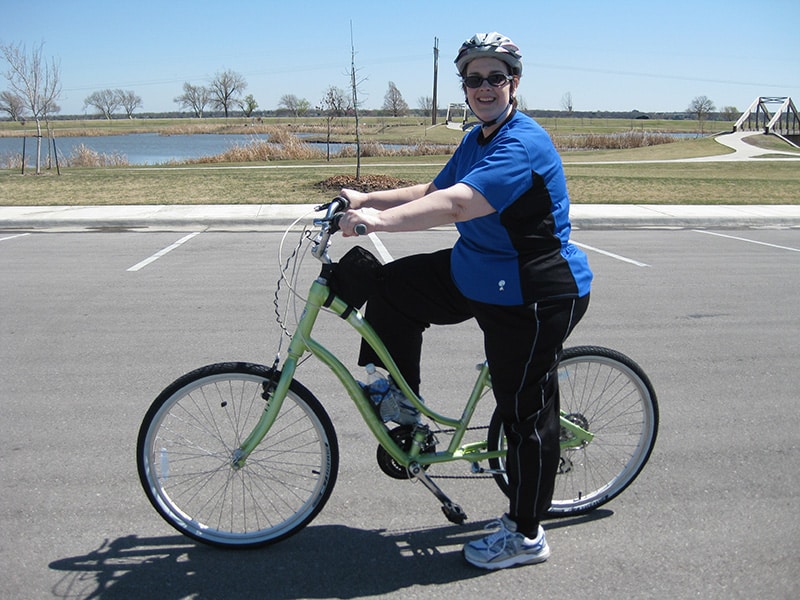
Amy Downs went for a bike ride one day and has since ridden hundreds of miles. (Photo courtesy of Amy Downs)
Soon after, her sister suggested she ride a bike. Using a loaner from her boss, Amy lasted 15 minutes. It was enough for her to call her sister and say, “That felt amazing.”
She “leveled up” from neighborhood rides to local events to a 50-miler, a 100-miler, even a seven-day trek across Oklahoma.
“When you’ve been encumbered by all that weight and then you don’t have it, you feel freedom,” she said. “You’re overcome with such gratitude that you can do things you couldn’t do before.”
***
The site of the bombing is now the Oklahoma City National Memorial & Museum. As a member of the board of directors, the newly fit Amy accepted an offer to hand out medals to finishers of the Memorial Marathon.
Seeing the excitement of everyone crossing the finish line, she wanted in on the fun.
“So, I tell everybody I am going to run next year in honor of my co-workers who were killed,” she said. “Then I talked a group at work into doing it with me.”
Wackiness ensued as Amy, a non-runner, played training group leader. She and 12 co-workers finished the half marathon in 2011.
That would’ve been it for her running career, except for a nagging thought: “What if you got a coach and trained properly?”
She signed up for the full marathon in 2012.
Her training period overlapped with her divorce. Two weeks before race day, a bicycle accident landed her in an emergency room.
About halfway through the 26.2 miles, drained by emotional and physical scars, Amy wanted to quit. A series of fortunate events – a friend passing on a bike, a stranger handing her a pain reliever, the perfect Rascal Flatts song on her headphones – revived her. Another series of events resulted in her coach and other friends welcoming her across the finish line.
“I was like, ‘I’m just going to trust that my life is going to end up better than I could have imagined it,'” she said.
It already was headed that way.
***
Ahead of turning 45, Amy decided to go for a 45-mile bike ride with friends through a wilderness refuge.
She needed help organizing and running the event. All her friends recommended Terry Head, who knew how to coordinate such things.
Amy met Terry for the first time in the months before the ride (which was a few weeks before the marathon). They continued getting together long after.
In 2014, they married.
***
Between biking and running, Amy was two-thirds of the way to competing in a triathlon. If only she knew how to swim.
Using her “trap yourself into success” technique, she signed up for a sprint triathlon. She leveled up to an Ironman 70.3 (a “half Ironman”).
“I have a video on Facebook of me telling my dad, ‘This is it – if I ever want to do anything crazy like this again, stop me,'” she said.
“But then I was turning 50 and wanted to do something big.”
In November 2017, she was in Scottsdale, Arizona, to swim 2.4 miles, ride 112 and run 26.2.
The event began before dawn. Near midnight, with her aching body begging her to quit, Amy calculated that she couldn’t finish before the cutoff point.
She’d miscalculated, though.
Corrected by her coach, Amy picked up her pace. Terry ran alongside her for a while. By the home stretch, she was the last person on the course.
“I saw myself on that big jumbotron and all the hands were reaching over the railing giving me high fives,” she said. “And then I heard (race icon) Mike Reilly say, ‘Amy Downs, you are an Ironman!’
“It’s probably the proudest moment of my life.”
Really?
“Because,” she said, “it has nothing to do with the bombing.”
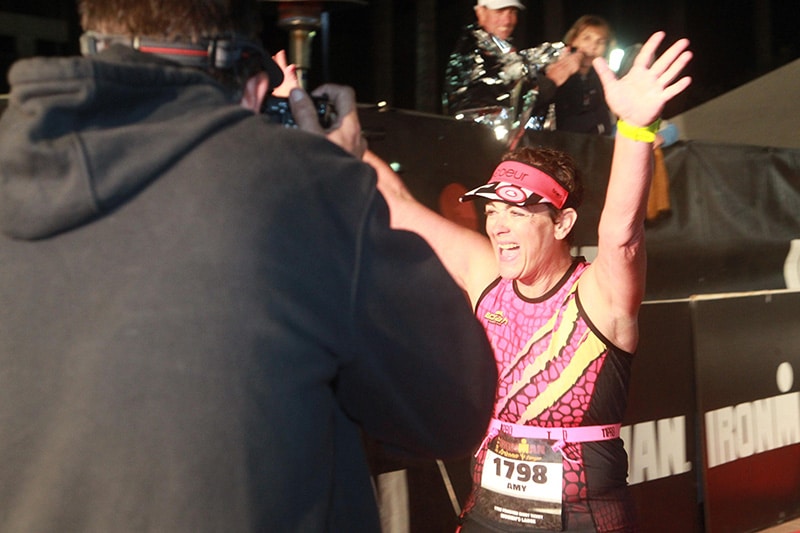
Amy Downs at the Ironman finish line. (Photo courtesy of Amy Downs)
***
Maybe not directly. Yet every time Amy has leveled up, the achievement can be traced to that awful experience. It’s the curse behind every blessing.
She knows she can never truly escape it.
Below her right knee, there’s a numb spot marked by “a really large scar.” A cosmetic surgeon made it less prominent during an operation to remove skin following her weight loss. She realized how much it bothers her when raving about a photo her sister took of the two of them resting during a bike ride.
“The scar is photoshopped out,” she said.
At Allegiance headquarters, memories are revived when she passes a remembrance garden. The area includes a fountain with granite slabs listing each bombing victim’s name. Amy and other survivors are listed on a wall behind it.
Those tributes weren’t in the initial plans. But the local credit unions, and other donors, raised so much money that there was enough left over for something else. Amy was part of the committee that decided to spend it this way.
“We wanted a place so that, 20 to 30 years from now, people would ask, ‘What’s that for?'” she said.
***
Amy has endured enough April 19s to know how to process her emotions. The fixed date on the calendar helps. But there’s a moving target that she and other survivors endure.
“We call it the April funk,” she said. “Whenever we start having spring days that are pretty and warm, you feel edgy and get overwhelmed really easily.”
To mark the 20th anniversary, she asked all her rescuers to join her in running the Oklahoma City Memorial half marathon. The only taker was Allen Hill, the man who’d found her. Although he’d never ran “farther than I had to,” he trained with his son to handle 13.1 miles. Lining up next to Amy, he felt ready.
“It was emotional getting started,” he said. “The rest of it was enjoyable. Finishing together was fun.”
As the 25th anniversary neared, the American Stroke Association – a division of the American Heart Association – planned a Cycle Nation fundraiser. Because of Amy’s love of cycling, she was asked to lead an Allegiance team.
She came up with a better idea: a commemoration of local credit unions rallying in her company’s time of need.
“What if we all come together again?” she thought.
The event was supposed to be a few days before the anniversary. It’s been postponed until August. Based on pre-pandemic fundraising, the generically named “OKC Credit Unions” is lapping the field. The leading team fundraiser is “The Cool CEOs,” which is Amy and her seven fellow local CEOs. In a further show of solidarity, they’re doing a relay, with each riding a mile.
“They all caught that credit union brotherhood vibe,” she said.
***
While overhauling her life, the book “The Purpose Driven Life: What on Earth Am I Here For?” inspired Amy to begin sharing her story. She decided to turn it into a book. After years of work, “Hope Is a Verb: My Journey of Impossible Transformation” published in March.
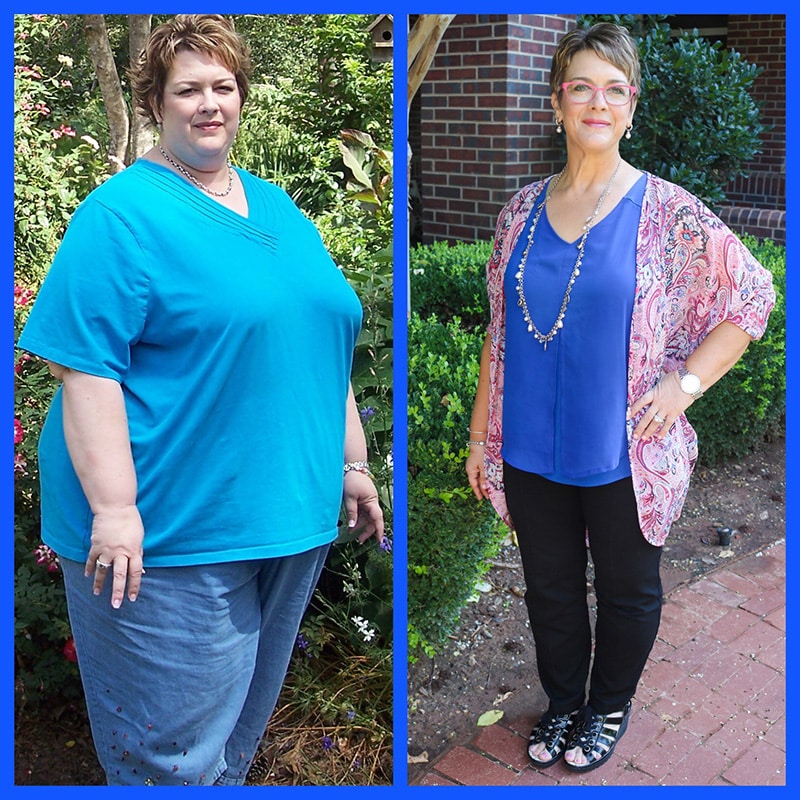
Amy Downs before and after her weight loss transformation. (Photo courtesy of Amy Downs)
“I’m trying to take something that was meant for evil and use it as a way to ignite hope in other people,” she said.
To Amy, the pandemic is the perfect time for her message.
“We will get through,” she said. “Those that get through and overcome will be those who can pivot to the new normal as quickly as possible.”
If you have questions or comments about this story, please email editor@heart.org
***
American Heart Association News Stories
American Heart Association News covers heart disease, stroke and related health issues. Not all views expressed in American Heart Association News stories reflect the official position of the American Heart Association.
Copyright is owned or held by the American Heart Association, Inc., and all rights are reserved. Permission is granted, at no cost and without need for further request, to link to, quote, excerpt or reprint from these stories in any medium as long as no text is altered and proper attribution is made to the American Heart Association News. See full terms of use.
HEALTH CARE DISCLAIMER: This site and its services do not constitute the practice of medical advice, diagnosis or treatment. Always talk to your health care provider for diagnosis and treatment, including your specific medical needs. If you have or suspect that you have a medical problem or condition, please contact a qualified health care professional immediately. If you are in the United States and experiencing a medical emergency, call 911 or call for emergency medical help immediately.

